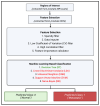A Transfer Learning-Based Framework for Classifying Lymph Node Metastasis in Prostate Cancer Patients
- PMID: 39457657
- PMCID: PMC11504638
- DOI: 10.3390/biomedicines12102345
A Transfer Learning-Based Framework for Classifying Lymph Node Metastasis in Prostate Cancer Patients
Abstract
Background: Prostate cancer is the second most common new cancer diagnosis in the United States. It is usually slow-growing, and when it is low-grade and confined to the prostate gland, it can be treated either conservatively (through active surveillance) or with surgery. However, if the cancer has spread beyond the prostate, such as to the lymph nodes, then that indicates a more aggressive cancer, and surgery may not be adequate. Methods: The challenge is that it is often difficult for radiologists reading prostate-specific imaging such as magnetic resonance images (MRIs) to differentiate malignant lymph nodes from non-malignant ones. An emerging field is the development of artificial intelligence (AI) models, including machine learning and deep learning, for medical imaging to assist in diagnostic tasks. Earlier research focused on implementing texture algorithms to extract imaging features used in classification models. More recently, researchers began studying the use of deep learning for both stand-alone feature extraction and end-to-end classification tasks. In order to tackle the challenges inherent in small datasets, this study was designed as a scalable hybrid framework utilizing pre-trained ResNet-18, a deep learning model, to extract features that were subsequently fed into a machine learning classifier to automatically identify malignant lymph nodes in patients with prostate cancer. For comparison, two texture algorithms were implemented, namely the gray-level co-occurrence matrix (GLCM) and Gabor. Results: Using an institutional prostate lymph node dataset (42 positives, 84 negatives), the proposed framework achieved an accuracy of 76.19%, a sensitivity of 79.76%, and a specificity of 69.05%. Using GLCM features, the classification achieved an accuracy of 61.90%, a sensitivity of 74.07%, and a specificity of 42.86%. Using Gabor features, the classification achieved an accuracy of 65.08%, a sensitivity of 73.47%, and a specificity of 52.50%. Conclusions: Our results demonstrate that a hybrid approach, i.e., using a pre-trainined deep learning model for feature extraction, followed by a machine learning classifier, is a viable solution. This hybrid approach is especially useful in medical-imaging-based applications with small datasets.
Keywords: deep learning; lymph node metastasis; machine learning; magnetic resonance imaging; prostate cancer.
Conflict of interest statement
The authors declare no conflicts of interest.
Figures





Similar articles
-
Machine Learning Model Development for Malignant Prostate Lesion Prediction Using Texture Analysis Features from Ultrasound Shear-Wave Elastography.Cancers (Basel). 2025 Apr 18;17(8):1358. doi: 10.3390/cancers17081358. Cancers (Basel). 2025. PMID: 40282532 Free PMC article.
-
Hybrid and Deep Learning Approach for Early Diagnosis of Lower Gastrointestinal Diseases.Sensors (Basel). 2022 May 27;22(11):4079. doi: 10.3390/s22114079. Sensors (Basel). 2022. PMID: 35684696 Free PMC article.
-
Lymph Node Metastasis Prediction from Primary Breast Cancer US Images Using Deep Learning.Radiology. 2020 Jan;294(1):19-28. doi: 10.1148/radiol.2019190372. Epub 2019 Nov 19. Radiology. 2020. PMID: 31746687
-
Artificial intelligence for pre-operative lymph node staging in colorectal cancer: a systematic review and meta-analysis.BMC Cancer. 2021 Sep 26;21(1):1058. doi: 10.1186/s12885-021-08773-w. BMC Cancer. 2021. PMID: 34565338 Free PMC article.
-
Prostate Cancer Detection from MRI Using Efficient Feature Extraction with Transfer Learning.Prostate Cancer. 2024 May 16;2024:1588891. doi: 10.1155/2024/1588891. eCollection 2024. Prostate Cancer. 2024. PMID: 38783970 Free PMC article. Review.
Cited by
-
Assessment of prostate cancer aggressiveness through the combined analysis of prostate MRI and 2.5D deep learning models.Front Oncol. 2025 Jun 30;15:1539537. doi: 10.3389/fonc.2025.1539537. eCollection 2025. Front Oncol. 2025. PMID: 40661774 Free PMC article.
References
-
- Key Statistics for Prostate Cancer—American Cancer Society. [(accessed on 28 September 2023)]. Available online: https://www.cancer.org/cancer/prostate-cancer/about/key-statistics.html.
-
- Prostate Cancer—Symptoms and Causes—Mayo Clinic. [(accessed on 28 September 2023)]. Available online: https://www.mayoclinic.org/diseases-conditions/prostate-cancer/symptoms-....
-
- Ghaderzadeh M. Clinical Decision Support System for Early Detection of Prostate Cancer from Benign Hyperplasia of Prostate. MEDINFO, IOS Press; Amsterdam, The Netherlands: 2013. p. 928. - PubMed
-
- Sadoughi F., Ghaderzadeh M. A Hybrid Particle Swarm and Neural Network Approach for Detection of Prostate Cancer from Benign Hyperplasia of Prostate. IOS Press; Amsterdam, The Netherlands: 2014. pp. 481–485. InE-Health–For Continuity of Care. - PubMed
Grants and funding
LinkOut - more resources
Full Text Sources

